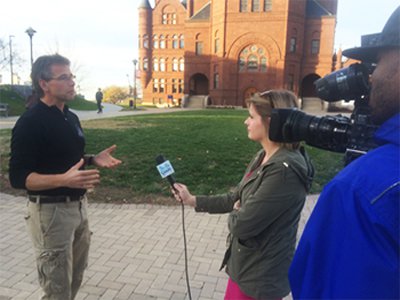Play It Again, Sam
Dedicated instructor appointed committee member for the American Association of Physics Teachers (AAPT)

Whether he's teaching physics, managing the labs or providing insight for local media, Sam Sampere wears many hats around campus. He's about to add another. Sampere has once again been appointed as a committee member for the American Association of Physics Teachers (AAPT). AAPT is dedicated to enhancing the understanding and appreciation of physics through teaching. In hearing Sampere's teaching philosophy, it's easy to understand why AAPT wanted his participation. During a recent break from his work, Sampere answered four questions.
Q. From a personal and a professional standpoint, what are your thoughts on the AAPT appointment?
A. I have been assigned to work on the AAPT Committee on Apparatus (it's the third time I've been appointed by AAPT). During my previous stint on this committee, I served as vice chair and then chair. The term is a three-year commitment. [I'd like to think that] placement on this committee means that I'm doing a good job and am recognized as an expert among my peers in terms of physics teaching apparatus.
Q. Physics involves rigorous course material not easily understood. How challenging do you find teaching potentially complex principals?
A. Students tend to stumble over their own feet with incoherent thoughts and processes. The challenge is learning where those stumbles happen, and then helping the students make those stumbles less severe to the point where they can walk smoothly through the physics landscape. Physics is all around us. Everywhere. Everyday. We have an intuitive understanding of how "nature" works. But sometimes we’re wrong. Confronting our own misconceptions and replacing them with new ones is difficult. That’s the challenge. And that’s where students tend to stumble. Students also stumble backing these ideas with math. Math is just another language, but many times, a barrier goes up. Practice can tear that down. They will hang on to their prior notions even if they "say" what we want them to say on the test. Physics builds on itself. Students hanging onto incorrect concepts will find it difficult to build new ones. The new ones rely on the old ones, if that makes sense.
Q. AAPT is dedicated to improving physics education. How can this be accomplished?
A. Each meeting that I attend, I return with new knowledge and ideas regarding teaching. The students benefit from this. I’ve been doing this for more than 20 years, and I am still learning, trying to make what we do here in the department better for our students.
Q. We hear a lot about the importance of STEM fields and STEM education. Syracuse University offers programs in which you and your colleagues bring high schoolers here for a taste of college coursework. Do you have any advice for college-bound juniors and seniors when it comes to furthering their education in the STEM fields?
A. Our world grows more technologically complex as we speak. And the problems we face as a society are technologically more complex as well. We need minds capable of understanding the issues, developing solutions and communicating both of these to the public and politicians. This involves physics, chemistry, biology, math, statistics, computer modeling …
Climate change is happening. Energy issues surround us. How to solve these? How do we communicate these? I think energy policy is the #1 most important issue this country faces, and is the root of numerous other problems. Solve this, and other problems are lessened, if not solved. Unfortunately, I do not hear much about this from our politicians. Pipelines are being planned, fracking seems to be running away from us, creating cheap energy now, but our politicians aren’t looking down the road to see what’s coming. This is important for high school students to understand.
